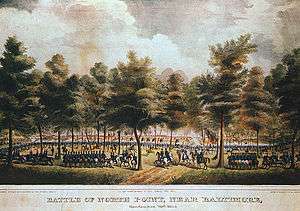Nathaniel F. Williams
Nathaniel F. Williams (1782–1864) was an American businessman and politician.
Nathaniel F. Williams | |
|---|---|
| Born | March 14, 1782 Roxbury, Massachusetts |
| Died | September 10, 1864 (aged 82) Baltimore, Maryland |
| Nationality | American |
| Alma mater | Harvard |
| Known for | Politician, War of 1812, Founding Savage Mill |
| Board member of | Trustee, University of Maryland |
| Spouse(s) | Caroline Barney, Maria Pickett Dalrymple |
| Children | Joshua Barney (1819-),[1] Joseph Barney (1830-), Ann B., Victoria B., Samuel, Caroline B., Sarah - Rebbecca D., Maria D., Dalrymple |
| Parent(s) | Joseph Williams, Susanna May |
| Relatives | Joseph (1764-1793), Susanna (1767-1812), Samuel (1769-1813), Mary (1771-1793), Lemuel (1774-1797), Amos Adams (1776), George (1778-1852), Martha (1780), Cumberland Dugan (1781-1840), Nehimeiah Davis (1786-), Benjamin (-1822) |
Early life

Nathaniel F. Williams was born 14 March 1782, in Roxbury, Massachusetts. He was the son of Joseph (born 1738) and Susannah (May) Williams. His grandfather, Colonel Joseph Williams (1708–1798), fought in the French and Indian War in 1755.[2][3] Before 1799, his brother Benjamin moved from Roxbury to 126 Lombard in Baltimore becoming wealthy in the shipping industry.[4][5] Benjamin's Daughter Susan May Williams, became well known for her relation to Napoleon through her marriage to Jérôme Napoléon Bonaparte.
He graduated from Harvard College in 1801. Serving as a lawyer in Boston and Annapolis. He married Caroline Barney, daughter of Anne and Commodore Joshua Barney in 1809. With his brothers, Amos, George and Cumberland, he founded the Savage Mill on land next to the Commodore Joshua Barney House in Maryland.
During this time he also served as an attorney for the Maryland Senate, Western Shore from 1811 to 1816. He served as a private, Baltimore Fencibles, War of 1812, becoming wounded at the Battle of North Point in 1814. He was considered dead after being shot on the battlefield in his hip. He was treated by Dr. Owens of the 5th regiment for two days, then sent home on a wagon cart. Nathaniel's brothers Cumberland Dugan, and George Williams were also on the roster of the Fencibles.[6][7][8]
When Luther Martin became ill, Williams became Acting Attorney General of Maryland serving from 1820 to 1822. Williams married Maria Pickett Dalrymple in 1829. He was the District of Maryland United States Attorney from 1824 to 1841 and served on the Executive Council from 1835 to 1837. He represented Baltimore City in the Maryland Senate in 1853. He was also a trustee, University of Maryland in 1826.[9] Williams died on September 10, 1864.
During his life he corresponded with Thomas Jefferson and John Adams.[10][11]
References
- Edwin C. Gibbons Jr. Vital Records of the First Independent (Now Unitarian) Church, Baltimore, Maryland 1818-1921. p. 47.
- Stephen West Williams. The Genealogy and History of the Family of Williams in America. p. 293–297.
- Ancestral Records and Portraits: A Compilation from the Archives of Chapter I, the Colonial Dames of America, Volume 2. p. 666.
- Chaim M. Rosenberg. The Life and Times of Francis Cabot Lowell, 1775–1817. p. 86.
- "Benjamin Williams". Retrieved 27 October 2015.
- The citizen soldiers at North Point and Port McHenry, September 12 & 13, 1814. Resolves of the citizens in town meeting, particulars relating to the battle, official correspondence and honorable discharge of the troops. Also, celebration of the seventy-fifth anniversary, 1889. Reprint. p. 13.
- "Meeting of the members of the Bar, Tributes of Respect". The Baltimore Sun. 13 June 1864.
- Ralph E. Eshelman; Scott S. Sheads. Chesapeake Legends and Lore from the War of 1812. p. 93.
- "Nathaniel F. Williams Maryland State Archives". Retrieved 6 September 2014.
- Williams, Nathaniel F. "To John Adams from Nathaniel F. Williams, 21 May 1823". Founders Online. National Archives. Archived from the original on 5 January 2020. Retrieved 5 January 2020.CS1 maint: BOT: original-url status unknown (link)[This is an Early Access document from The Adams Papers. It is not an authoritative final version.] Also available via Internet Archive as captured on January 5, 2020. .
- Williams, Nathaniel F. "To Thomas Jefferson from Nathaniel F. Williams, 25 March 1826". Founders Online. National Archives. Retrieved 5 January 2020.[This is an Early Access document from The Papers of Thomas Jefferson: Retirement Series. It is not an authoritative final version.] Also available via Internet Archive as captured on January 5, 2020. To Thomas Jefferson from Nathaniel F. Williams, 25 March 1826.